The computer does not read the USB flash drive what to do. The other most common reasons why a flash device is faulty. A message about the need to format the disk.
External hard drives and USB flash drives are mostly easy to use - you plug them into the appropriate connector, and you can immediately work, record and rewrite information. Their convenience and indispensability can hardly be overestimated. But in some cases, when you connect a removable media to the USB port, you find that the computer does not see the USB flash drive, and the drive indicator is off.
The malfunction could be caused by partition errors (for example, the wrong file system is being used), broken USB ports, driver problems in Windows, or other problems. In the worst case, the flash drive itself may simply be damaged during operation or as a result of mechanical damage, but, however, a new flash drive may not work when connected.
Let's take a closer look at why the computer does not see the USB flash drive and what to do to fix the problem yourself.
Let's make a reservation right away - sometimes a malfunction, due to which a flash drive is not or another device, may be in the BIOS. For example, support is disabled in BIOS settings USB devices- this is why the computer does not see the USB flash drive.
But it happens that the BIOS itself cannot identify a removable device. For example, you created bootable USB drive but it is not recognized when the computer boots up.
Why can this happen? If, in the settings, the boot priority is set to a removable device, most likely, the created bootable flash media was simply written incorrectly. You should re-create the bootable USB flash drive using programs that can be easily found on the Internet and then try to use it again and check if it works on another computer.
The indicator is on, but the flash drive is not recognized
In this case, most likely there is still a chance to restore it, or maybe the problem is not in it. This means that the situation is not fatal. Because, in essence, the indicator light means just no power supply. That is, the device may turn out to be quite working.
What could be the reason?
USB port The front panel s are not connected - this is perhaps one of the most common reasons. Often, users plug a USB flash drive into the front USB port and find that the indicator does not flash - it so happens that when assembling the computer, the cable was not connected to these ports.
There are two solutions, and both of them are quite obvious and understandable. First, plug the removable storage into the rear USB port, if everything works, the problem is in the front ports. The second option is to check and, if there is no connection, connect the cable from the front ports to motherboard computer.
Other most common reasons why a flash device is faulty
First, let's check if Windows detects the drive when you plug it into your computer. If you are using a portable hard drive, connect it to your computer via USB cable... Some removable drives may have separate power cords that need to be plugged in before everything starts working.
To check if the external HDD or USB stick, open the management tool. To do this, press Win + R, enter the combination diskmgmt.msc in the dialog box.
You should see a connected external drive among those listed in the Disk Management window. Even if it doesn't appear in File Explorer, since it doesn't contain any sections (not formatted), it should appear here.
If you see a drive in this menu, it means that Windows has detected it, after which you can format it and the device will be ready to use. If you do not see the removable device in the control window, go to the next section, in which we will try to determine, due to what reason, the computer does not see the USB flash drive.
Special connection options
Some users prefer to connect a USB flash drive via a USB hub or extension cable. This, of course, is sometimes more convenient, but the malfunction in this case also happens in the adapters. Try making a direct connection.
And it happens that a lot of devices are connected via USB to a computer (for example, through the same hub, in itself it is quite working), and there is simply not enough power for flash drives. This, however, is quite rare in modern cars, but it still remains quite possible. Try disconnecting other devices, and if everything works, that's the problem. In this case, the solution may be to install a more powerful power supply or simply not use too many devices at the same time.
USB port problems
If Windows does not see your removable drive in any modes and after formatting too, there may be a hardware problem with the USB port, a driver problem, or simply the connected device has a malfunction. What to do in such cases?
First, unplug the drive from the USB port and try plugging it into a different USB port. If it works in one but doesn't activate in the other, your USB connector may be broken. If you plugged the drive into a USB hub, try connecting it directly to your computer. Some USB hubs do not provide enough power for your external drive.
If the drive does not appear in the management program even after you unplug the USB hub and plug it into a different port on your computer, it’s hard to guess for sure if the removable media is bad or if the computer's motherboard is having problems.
If you have another computer nearby, try plugging the USB device directly there to see if the hardware is detected. If the media does not work on any computer when connected - do not forget to check if it appears in the disk management window - if not, most likely, the device itself is damaged, and you will need to replace (buy a new one) or repair it.
If the drive works on other computers or you do not have another computer nearby, check it on the Windows system there may be a driver problem with the attached storage devices. You can check this with Device Manager.
To open it, press Win + R, enter the combination "devmgmt.msc" in the dialog box and press Enter.
And sometimes it also happens that a virus appears in the system that has infected the file of the USB drive. In this case, the device either does not boot at all, or the antivirus simply blocks it.
Sometimes the flash drive is still recognized, but when accessing, an access denied error appears. In this case, it is usually worth deleting the autorun.inf file via command line- first Start, then Run, then "cd F: /" (or what drive letter is used for the flash drive), then the command "attrib -a -s -h -r autorun.inf"; "Enter"; command "del autorun.inf"; Enter. In this case, it is better not to turn off the antivirus in order to avoid infecting the system.
Drivers
Look in the manager connected to this moment devices to check for equipment with a yellow exclamation mark next to them. If the flash drive's indicator is off and you see a yellow exclamation mark, there is no doubt - this indicates a problem with the drivers.
Right-click on the device with a yellow exclamation mark, select the Properties option, and look at the error message. This bug report can help you fix the problem, but you can search Google to find out the true problem in a specific case. Be sure to enter the code if present, or retype the error exactly to get the most accurate information that will help solve your driver problem.
System Restore
Problems with a USB flash drive can sometimes be difficult to fix. If the malfunction has occurred recently, you can take extreme measures - run System Restore. You can use the Update Driver button to install an updated, good driver and roll back any changes, or use the Uninstall function to remove the device from the system, hoping that Windows will automatically reinstall the driver and then configure it correctly when reconnecting USB storage.
There are many reasons why you may face the fact that the computer does not see the USB flash drive. The problem can manifest itself in any version of the operating system from Microsoft - Windows 10, 8, Windows 7 or XP. If the computer does not recognize the connected USB flash drive, this can manifest itself in several variations:
- The computer writes "insert disk" even when the flash drive was just connected
- The icon of the connected flash drive and the connection sound just appear, but the drive is not visible in the explorer.
- Writes what needs to be formatted, since the disk is not formatted
- A message appears stating that a data error has occurred
- When you insert a USB flash drive, the computer freezes
- If your computer says that the device is not recognized, you should start with these instructions:
- Separate instruction:.
In this manual I will describe all the ways I know to solve this problem. First, the simplest and, at the same time, the most effective methods will go in most situations when the computer does not see the USB flash drive, reports that the disk is not formatted, or gives other errors. There are also separate instructions on how.
If the methods described at the beginning will not help "cure" the problem, move on to the next - until the problem with the flash drive is resolved (unless it has serious physical damage - then there is a possibility that nothing will help). Perhaps, if the following does not help, another article will be useful to you (provided that your flash drive is not visible on any computer): (Kingston, Sandisk, Silicon Power and others).
Windows USB Troubleshooter
I recommend starting with this, the safest and easy way: Recently, the official Microsoft website has its own utility for fixing problems with connecting USB drives, compatible with Windows 10, 8 and Windows 7.

After running the utility, all you need to do is click the Next button and see if the problems have been fixed. During the error correction process, the following items are checked (descriptions taken from the troubleshooter itself):
- The USB device may not be recognized when connected via the USB port due to the use of high and low filters in the registry.
- The USB device may not be recognized when connected via the USB port due to the use of damaged high and low filters in the registry.
- USB printer does not print. This is most likely caused by a print failure or other problem. In such a case, you may not be able to turn off the USB printer.
- Cannot remove the USB storage device using the Safely Remove Hardware function. You may receive the following error message: Windows cannot stop Universal Volume device because it is being used by programs. Quit running any programs that might be using this device, and then try again. "
- Windows Update is configured so that drivers are never updated. When driver updates are found, Windows Update does not automatically install them. For this reason, the USB device drivers may be out of date.

In case something has been fixed, you will see a message about it. It also makes sense to try reconnecting your USB drive after using the USB troubleshooter. You can download the utility from the official Microsoft website.
Check if the computer sees the connected USB flash drive in "Disk Management"
Start the disk management utility in one of the following ways:
- Start - Run (Win + R), enter the command diskmgmt.msc, press Enter
- Control Panel - Administrative Tools - Computer Management - Disk Management

In the disk management window, pay attention to whether the flash drive appears and disappears when it is connected and disconnected from the computer.
Ideal - if the computer sees the connected USB flash drive and all partitions on it (usually one) are in the "Good" state. In this case, just right-click on it, select in context menu"Make the partition active", and, possibly, assign a letter to the USB flash drive - this will be enough for the computer to "see" USB disk... If the section is faulty or deleted, then in the status you will see "Not allocated". Try right-clicking on it and, if such an item is found in the menu, select "Create Simple Volume" to create a partition and format the flash drive (this will delete the data).
Further simple steps
Try to go to the device manager and see if your device appears as unknown, or in the "Other devices" section (as in the screenshot) - the drive can be called there by its real name or as a USB mass storage device.
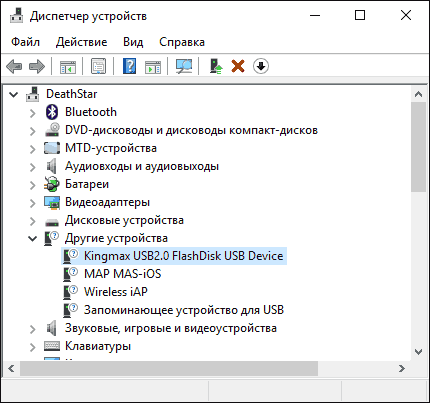
Click on the device with the right mouse button, select Uninstall, and after deleting it in the device manager, select Action - Update hardware configuration from the menu.
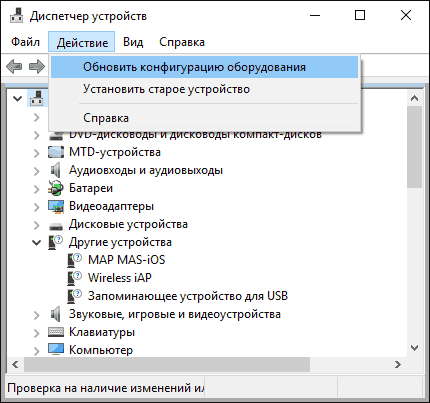
Perhaps this action will already be enough for your flash drive to appear in Windows Explorer and was available.
Among other things, the following options are possible. If you connect a USB flash drive to a computer via an extension cable or USB hub, try connecting directly. Try plugging into all available USB ports. Try turning off your computer, disconnecting all extraneous devices from USB (Webcams, external hard disks, card readers, printer), leave only the keyboard, mouse and USB flash drive, then turn on the computer. If after that the flash drive works, then the problem is in the power supply on the USB ports of the computer - perhaps there is not enough power from the PC power supply. Possible Solution- replace the power supply or purchase a USB hub with its own power supply.
Windows 10 does not see a USB flash drive after an update or installation (also suitable for Windows 7, 8)
Many users have faced the problem of not displaying USB drives after upgrading to Windows 10 from previous OS, or after simply installing updates on already installed Windows 10. In this case, it often happens that flash drives are not visible only via USB 2.0 or USB 3.0 - ie. it can be assumed that USB drivers are required. However, in fact, this behavior is often caused not by drivers, but by incorrect entries in the registry about previously connected USB drives.In this case, the free USBOblivion utility can help, which removes from windows registry all information about previously connected flash drives and external hard drives... Before using the program, I recommend it.

Disconnect all flash drives and other USB storage devices from the computer, run the program, check the Perform a real cleanup and Save undo reg file, then click the Cleanup button.
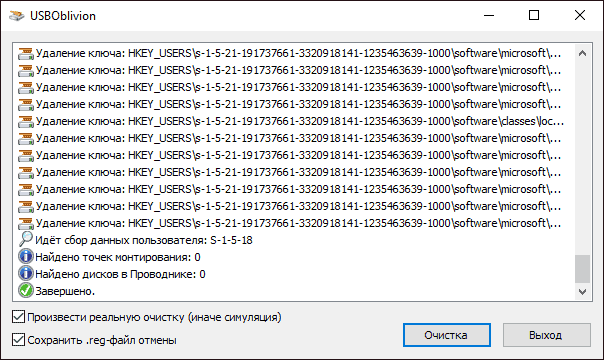
After cleaning is complete, restart your computer and connect the USB flash drive - with a high probability, it will be detected and become available. If not, then also try to go to the device manager (through the right click on the Start button) and follow the steps to remove the USB drive from the Other devices section and then update the hardware configuration (described above). You can download the USBOblivion program from official page developer: www.cherubicsoft.com/projects/usboblivion
But, in relation to Windows 10, another option is also possible - a real incompatibility USB drivers 2.0 or 3.0 (usually then they are displayed with an exclamation mark in Device Manager). In this case, the recommendation is to check the availability of the required USB drivers and chipset on the official website of the laptop or PC motherboard manufacturer. At the same time, I recommend using the official websites of the manufacturers of the devices themselves, and not the sites of Intel or AMD to search for such drivers, especially when it comes to laptops. Also, sometimes the problem is solved by updating the BIOS of the motherboard.
If the flash drive does not see Windows XP
The most common situation I encountered when calling for setting up and repairing computers, when a computer with the Windows XP operating system installed on it did not see the USB flash drive (even if it sees other flash drives), was caused by the fact that the necessary updates were not installed to work with USB drives ... The fact is that many organizations use Windows XP, often in the SP2 version. Updates, due to restrictions on Internet access or poor performance of the system administrator, were not installed.
So, if you have Windows XP and the computer does not see the USB flash drive:
- If SP2 is installed, update to SP3 (when updating, if you have installed Internet Explorer 8, delete it).
- Install all Windows XP updates, regardless of which Service Pack is used.
Here are some of the fixes for working with USB sticks released in Windows updates XP:
- KB925196 - fixed errors in the fact that the computer does not detect the connected USB flash drive or iPod.
- KB968132 - fixed errors when, when connecting multiple USB devices in Windows XP, they ceased to function normally
- KB817900 - USB port stopped working after removing and re-inserting a USB flash drive
- KB895962 - USB flash drive stops working when the printer is turned off
- KB314634 - the computer sees only old flash drives that were connected before and does not see new ones
- KB88740 - Rundll32.exe error when inserting or removing a USB flash drive
- KB871233 - the computer does not see the USB flash drive if it has just been in sleep or hibernation mode
- KB312370 (2007) - USB 2.0 Support on Windows XP
By the way, despite the fact that Windows Vista is almost never used anywhere, it should be noted that installing all updates should also be the first step when a similar problem occurs.
Remove old USB drivers completely
This option is suitable if the computer says "Insert disc" when you insert the USB flash drive. Old USB drivers available in Windows can cause this problem, as well as errors associated with assigning a letter to a USB flash drive. In addition, this can also be the reason that the computer restarts or freezes when you insert a USB flash drive into the USB port.
The fact is that by default Windows installs drivers for USB drives the moment you first connect them to the corresponding port on your computer. At the same time, when the flash drive is disconnected from the port, the driver does not disappear anywhere and remains in the system. When connecting a new flash drive, conflicts may arise caused by the fact that Windows will try to use the previously installed driver corresponding to this USB port but a different USB storage device. I will not go into details, but simply describe the steps required to remove these drivers (in the manager Windows devices You won't see them).
How to remove drivers for all USB devices
- Turn off your computer and disconnect all USB storage devices (and not only) (flash drives, external hard drives, card readers, webcams, etc. The mouse and keyboard can be left on, provided that they do not have a built-in card reader.
- Turn on your computer again.
- Download the DriveCleanup utility http://uwe-sieber.de/files/drivecleanup.zip (compatible with Windows XP, Windows 7 and Windows 8)
- Copy the 32-bit or 64-bit version of drivecleanup.exe (depending on your Windows version) to the C: \ Windows \ System32 folder.
- Run Command Prompt as Administrator and type drivecleanup.exe
- You will see the process of removing all drivers and their entries in the Windows registry.

When the program finishes, restart your computer. Now, when you insert the USB flash drive, Windows will install new drivers for it.
Update 2016: It is easier to perform the operation to delete mount points of USB drives using free software USBOblivion, as described above in the section on non-working flash drives in Windows 10 (the program will work for other Windows versions).
Reinstalling USB Devices in Windows Device Manager
If none of the above has helped yet, and the computer does not see any flash drives at all, and not just one specific one, you can try the following method:
- Go to Device Manager by pressing Win + R keys and entering devmgmt.msc
- In the device manager, open the section USB controllers
- Remove (right click) all devices named USB Root Hub, USB Host Controller or Generic USB Hub.
- In Device Manager, select Actions - Update Hardware Configuration from the menu.
After reinstalling the USB devices, check if the USB drives on your computer or laptop are working.
Additional actions
- Check your computer for viruses - they can cause inappropriate behavior of USB devices
- Check the Windows registry, namely the key HKEY_CURRENT_USER \ Software \ Microsoft \ Windows \ CurrentVersion \ Policies \ Explorer... If you see a parameter named NoDrives in this section, delete it and restart your computer.
- Go to the Windows registry key HKEY_LOCAL_MACHINE \ System \ CurrentControlSet \ Control... If the StorageDevicePolicies parameter is present, remove it.
- In some cases, a complete blackout of the computer helps. You can do it like this: unplug the flash drives, turn off your computer or laptop, unplug it (or remove the battery if it's a laptop), and then, while the computer is off, press and hold the power button for a few seconds. Then release it, reconnect the power supply and turn it on. Oddly enough, this can sometimes help.
Recovering data from a flash drive that the computer does not see
In case in management Windows disks the computer displays the USB flash drive, but in the "Not recognized", "Not initialized" state, and the partition on the USB flash drive is "Not allocated", then most likely the data on the USB flash drive is damaged and you will need to use data recovery.
There are several things to keep in mind that increase the likelihood of successful data recovery:
- Do not write anything to the USB flash drive you want to recover
- Do not try to save the recovered files to the same media from where they are being recovered
If all else fails, and your computer still does not see the USB flash drive, and the files and data stored on it are very important, then the last recommendation would be to contact a company that is professionally engaged in file and data recovery.
Over the past few years, flash storage media have become very popular and are used by us, literally, every day, due to their advantages over disk media. It is hardly possible to overestimate its usefulness of a flash drive, because you can quickly write information or read it on it, it does not take up much space in a portfolio or bag, and the price segment is pleasantly pleasing.
Despite all the positive aspects, sometimes there are situations when the data cannot be read due to the flash drive itself or the computer. Indeed, at the most important moment, you can lose access to the stored files, and in order to quickly return everything to normal, you need to have certain knowledge. In this article, we will analyze all possible problem situations and find ways to solve why the computer does not see the USB flash drive.
The most common problems why the computer does not see the USB flash drive:
The flash drive itself does not work
This is the worst scenario for a person whose documents are stored on a USB flash drive, because it is practically impossible to bring it back to life. It is possible to disable a USB flash drive by mechanical action on the device chip or its controller, by shorting electrical circuit, damaged contacts on the USB board. This is what a USB flash drive looks like after the electrical circuit is closed or moisture gets inside the drive.
 Determining if this happened to your drive is easy enough. The very first thing you need to do is check the USB flash drive for mechanical damage, chips, cracks, etc. If it is completely broken, you can look for a replacement at a computer peripheral store. If you doubt its inoperability, you can check it with a practical method.
Determining if this happened to your drive is easy enough. The very first thing you need to do is check the USB flash drive for mechanical damage, chips, cracks, etc. If it is completely broken, you can look for a replacement at a computer peripheral store. If you doubt its inoperability, you can check it with a practical method.
Connect the USB flash drive to the USB connector of the computer, if the LED on it lights up and on the computer you hear a sound that is typical for connecting a new device, then everything is in order, it makes sense to look for the problem further. If this does not happen, most likely the flash drive is no longer usable.
You can try to carry the USB stick to service center, where the wizard will try to rewire the contacts or replace the controller, but it will be very expensive, and this action will be justified only if you have important documents stored on it. If no fatal malfunction was detected and the flash drive shows signs of life, try the methods to restore its performance, which will be described below.
The USB port on the front of the computer is de-energized
This problem is very common among desktop PC users. Most computer owners are accustomed to plugging a USB stick into the front USB ports because it's quick and easy.
But there is a situation when, for some reason, during the assembly of the PC, the front panel is not connected to the power system, usually this happens due to the forgetfulness of the computer master. Accordingly, your flash drive will not be displayed, despite its complete serviceability.

This problem can be solved in two ways. If you urgently need to use the information on removable media, you can connect it to the back of your computer. The front connectors will still be inoperative, but you will get access to the documents. It is impossible to call such manipulations a full-fledged solution, so we will consider the second option.
Method # 2 involves connecting the power cable on the motherboard to the front panel of the computer. The connection connectors may differ depending on the model of the computer case. But do not be scared, they all have markings and you will not be able to connect the wrong connector due to design features. The most common wires are "VCC", "D-", "D +" and "GND" types. Moreover, color coding the cable and connector on the motherboard are the same, but it is better to keep the reference point according to the inscriptions.
The first step is to gain access to the motherboard, to do this, unscrew the mounting bolts on the case and remove the cover. Find the cable that leads to the bezel and locate the same connector on the motherboard. In the image below, you can see what the connector should look like.

It is not recommended to make the connection yourself, it is better to call the wizard. If you connect the cable and connector incorrectly, you can burn these contacts and even devices. If you decide to connect the front USB connectors, then it is better to tell us the model of your case and motherboard, and we will show you how to do it correctly and explain what the connector and cable look like.
Faulty or disconnected USB port on the computer
Sometimes the problem of unreadable information on removable media is associated not with the problem of the flash drive itself, but with the connector into which it is connected. A certain USB port may be inoperative, and this condition can be caused by trivial damage to the connector pins. Then, not only a flash drive, but also other USB devices will not work in this port.
Decide this problem you can, armed with an ordinary soldering iron and minimal knowledge of circuitry. If there is no such knowledge, skill and equipment, then this can be corrected at the nearest service center for a low fee.
However, if there is no reaction to USB connection the device is not observed on all connectors, then the problem may lie deeper. Ports can be disabled in BIOS settings.
In order to connect ports in the BIOS menu, you need to get there initially. To enter the BIOS in the first seconds of booting the computer, you need to press the corresponding key on the keyboard, which is responsible for calling up the menu. Most often, the F2 or Del key is set by default, but depending on the motherboard company and the BIOS version, it may be different. In the first image that pops up when loading it is indicated.
After you have entered the BIOS itself, we need to go along the following route: “”.

Find the line “USB Controller” so that you are allowed to use the ports, opposite should be the value “Enabled”.
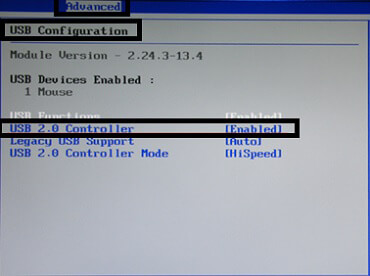
After you have enabled the USB ports on your computer, press the F10 key. This will save the settings you made and exit the BIOS.
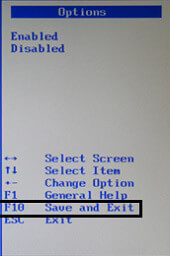
The USB connector of the flash drive is dirty
The flash drive is mobile device storage of information and therefore is often carried in pockets, briefcases or as a key ring. Due to these operating conditions, dust may accumulate in the connector. small rubbish... This does not happen often, but it can cause the flash drive to malfunction. Dust and debris build up on the contact and prevent connections from the contacts in the port on the computer. Such a flash drive may not only not be displayed at all, but also freeze, slowly transmit or read information and not be detected the first time.
To clean the USB connector of a flash drive, arm yourself with a match and a cotton swab. Using a match, remove all debris from the connector, and then moisten cotton swab alcohol and wipe the contacts of the flash drive. This will help keep it free of debris and oxidation.
Infection with viruses
Nowadays, the issue of the security of the storage device is becoming more and more urgent, because viruses are in full swing. You can visit the site you are used to social network on the Internet and get infected, not to mention downloading files from unverified sources.
Modern computer viruses can also multiply, no matter how strange it sounds. They infect files on your USB flash drive or computer hard drive, and their number grows exponentially.
Very often, the problem of the inoperability of a flash drive is a virus infection. The drive is detected by the system, you can hear the characteristic sound of connecting the device to the system, but when you try to read the information, you will see the message "" or " Application not found».

Before solving this problem, it is worth installing antivirus software on your computer and conducting full diagnostics files. To access the data on the drive, we need to delete the file with the virus and scan it. To do this, go to the "Start" menu and enter the following phrase "" in the search line.

Click on the found element with the left mouse button. Before you will be open window with the name "Folder Options", here you need to do the following:
- Uncheck the " Hide protected system files»
- Check the box ""
After that, be sure to press the "Apply" button and only after that "OK", otherwise the changes will not take effect. It should look like this.

After that, go to "My Computer" and go to the folder of the drive itself. There you will see the "Autorun" file, you need to delete it, and check the USB flash drive for viruses with one of the free antivirus, the Dr.WEB Cure It utility can handle it perfectly.
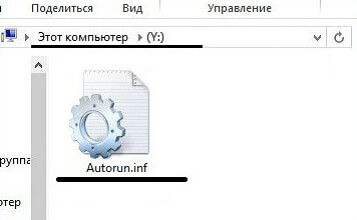
Now you can fully use the USB flash drive and no problems should arise. If nothing has changed, then the problem lies in the absence of drivers, we will analyze it below.
Driver failure or outdated drivers
A very common problem is when the computer does not want to display a USB flash drive due to outdated drivers or their system failure. The failure can occur due to a power surge or an unexpected shutdown of the operating system. Or, older computer models may not work with 32GB or larger drives. We can say one thing, the problem is solved only by updating the drivers.
The first step is to go to "". This can be done in several ways, for example, through "My Computer" or find this section in the system search, as we will do.
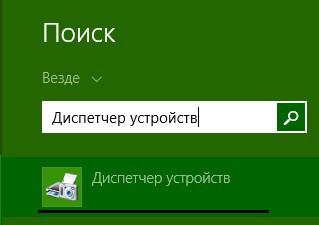
We go into this menu, after which we connect the flash drive to the computer, and then open the “USB Controllers” sub-tab. Select the line “ Memory device", By clicking the right mouse button opens the system menu and press" Delete ".

Such manipulations allow you to remove the driver installed on the system for your storage device. As soon as you remove it, feel free to remove the USB flash drive from your computer and reconnect it. Then the driver on the flash drive will be reinstalled and the problem will be solved.
If the problem persists, it may be necessary to update the driver of all USB chipsets, this is quite easy to do. You can use the special disc that came with motherboard, it contains all required drivers... If you do not have it, download the DriverPack program, it will automatically select all drivers for which there is an update and will carry out this procedure after your agreement.
Moreover, most users have doubts about the correctness of their actions when they learn about the different USB formats. Don't be scared!
Drivers for USB 2.0 and USB 3.0 are installed according to the same principle. And the only difference between the ports is maximum speed reading and writing information.
Filesystem errors
The computer may also not detect your flash device due to file system errors. Let's check if this is so, go to "", as described above. Now you need to open the sub-tab “ Disk devices", If you see your USB flash drive there, it means that it is working properly, and the file system does not perceive it as it should, and, accordingly, does not display it in the explorer. In my case, the flash drive is displayed, which means it is working properly.
To fix this problem, you must format your USB flash drive, but this action has several nuances, so we will consider this process in the next paragraph of the article.
If you do not see your drive there, then the problem lies in the malfunction of the flash drive itself, which means either the controller has burned out or the contact is unsoldered. Experts in service centers can try to bring it back to life. However, this is an expensive undertaking, it is easier to buy a new one, of course, if important information was not recorded on the faulty one and you need to restore the data on the USB flash drive.
File system conflict
Quite often, the contents of a flash drive are not displayed due to a conflict between file systems on the computer and the removable media itself. For example, if the computer operates on a file NTFS system and on the flash drive FAT32 is used, a conflict situation is not excluded. Moreover, this problem is widespread not only in Windows environment but also Mac OS. For example, if you format a USB flash drive on your Mac device to the ExFAT system or the standard MacBook file system, then the flash drive is unlikely to be read on Windows devices.
The very first thing to do is to find a computer where a different file system is used, open the USB flash drive and save the information that is important to you, because after formatting it will be lost.
To solve this problem, we need to carry out the process of formatting the flash drive. First you need to find out which file system is used on your computer. Go to "My Computer", right-click on the hard drive, open the submenu and select "Properties" in it.

In the window that opens, you will see information about the free and used amount of disk space, as well as find out which file system is used. In my case, the NTFS system is used.

After you know the file system of the computer, we need to format the flash drive to the same system. To do this, click on the flash drive right key mouse and open the "Format" tab.
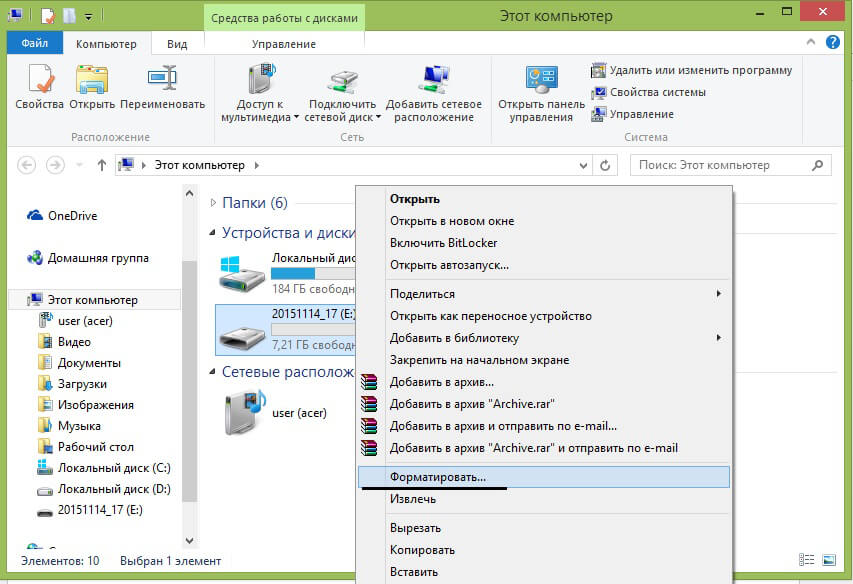
In the tab that opens, select the file system into which we will format, put a tick in front of the "Fast" attribute and click "Start".

A few words about why we are using the Fast attribute. First, the formatting of the flash drive will be much faster. But there is also another side of the coin. If there were any documents on the flash drive, then only with a quick format can you recover this data using special utilities. If you have not checked the box, then the information that was on the flash drive will be lost for you forever.
The flash drive is not formatted
A fairly common problem is when you insert a USB flash drive into a computer (basically this is a new USB flash drive and its first use), and the operating system gives you a warning, which says that the removable drive needs to be formatted before use. And if the flash drive was used earlier and data is recorded on it, then you will not be able to access them. Moreover, the volume of the flash drive becomes 0, i.e. as if there was nothing there at all, not even a drive.
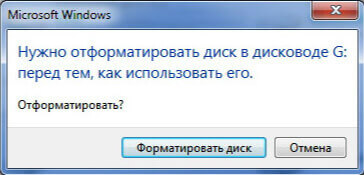
If you have already used a USB flash drive and this is not its first connection, then try connecting it to another computer, perhaps the problem will go away and you can save the data. But in any case, the flash drive must be formatted. How to do this was discussed in detail in the section "Conflict of file systems".
But I want to draw your attention to two points. So that after formatting there are no problems with file system(FS), find out which FS is used on the computer and install the same for the drive. And secondly, if the information you need was on the flash drive, then be sure to use the "Fast" attribute, so the formatting of the flash drive will only go through the table of contents, and the lost information can be returned using special utilities.
A problem with a partition or a USB flash drive is automatically assigned a busy letter
There are situations when the operating system incorrectly detects your removable media. It seems that everything is fine, the connection of the device is highlighted and the icon of the flash drive appears in the tray, but you cannot use it for its intended purpose.
The problem may be that the system did not assign the partition a letter under which the removable drive will appear, or it assigned it, but this letter is already taken, and because of this, an address conflict is obtained.
The solution to this problem will be the forced assignment of the partition letter that we choose, everything happens in manual mode. So let's get started.
The first step is to hold down the key combination "Win + R", a window with the name "Run" will open in front of you.
In the line we need to enter a simple command diskmgmt.msc, which will transfer us to the disk and storage management section.
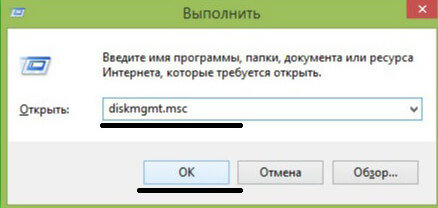
In the opened storage media manager, we need to define our USB device. This can be done simply, disconnect the USB flash drive and reconnect it, the partition that first disappears and then appears is what we need.
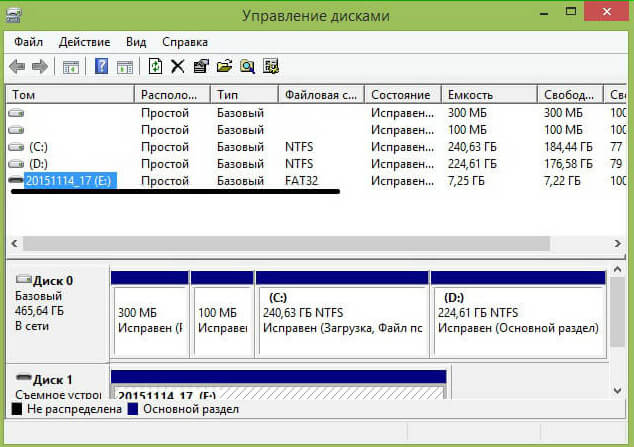
In my case, the flash drive is a drive named "20151114_17", you can also identify it by a special icon. Now you need to click on it with the right mouse button, and in the menu that opens, select the "Change letter" item.
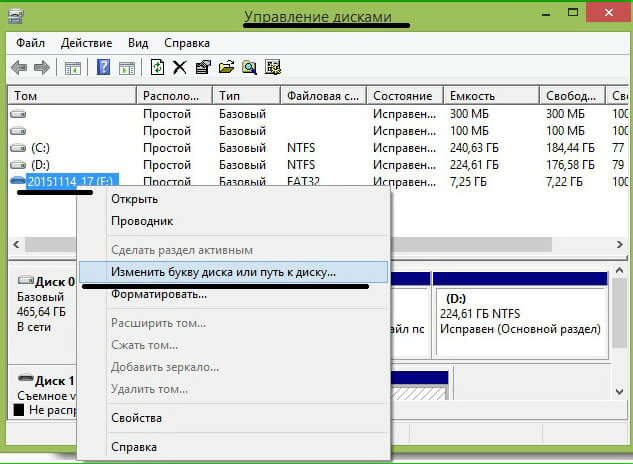
Now another additional window, smaller, will open in front of us. In it, you must click on the "Change" and "OK" button.
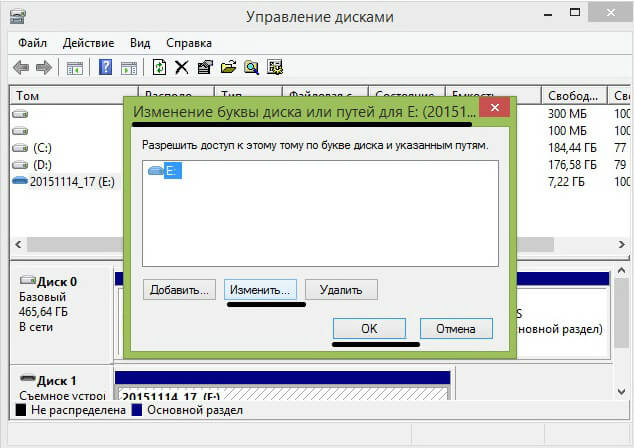
Now another auxiliary window will open, where you must select any letter of the English alphabet, and after clicking on the "Ok" button, the letter will be assigned to the section.
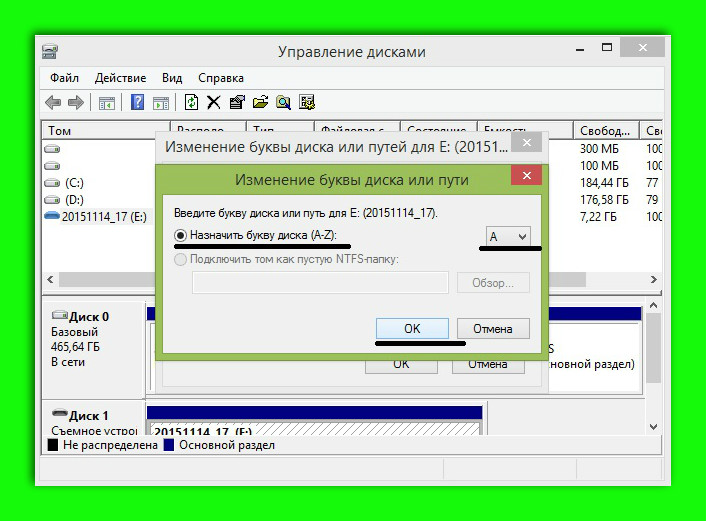
It is worth paying attention to one important point! When choosing a letter to be assigned to a partition of your flash drive, look at which letters are already in use by the system. This is very important, because we may not fix the problem, but leave it. This will happen if, for example, you designate a flash drive partition through the letter “D”, which is already assigned to the local disk.
Power supply malfunction or excessive overcurrent of the USB port
This problem is very common in our time. The fact is that the computer may simply not see the USB flash drive due to a faulty power supply. Let's figure it out in order, the power supply consumes electrical energy from the network, and then converts and distributes it to all nodes of the computer. It has a power limit, for example, a 400W power supply will not be able to give you 600W. This means that the consumption of the entire system must be balanced.
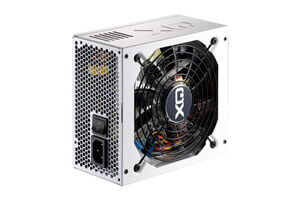 Such a problem may appear if you have recently replaced some important node in the system, let it be a processor. Now it consumes much more energy, in comparison with the past, which means that it simply does not reach somewhere, and in this case this “somewhere” is the USB network of the computer. Accordingly, the power consumption parameter must be calculated in advance, and if such a situation has already occurred, you will have to replace the power supply unit with a more powerful one.
Such a problem may appear if you have recently replaced some important node in the system, let it be a processor. Now it consumes much more energy, in comparison with the past, which means that it simply does not reach somewhere, and in this case this “somewhere” is the USB network of the computer. Accordingly, the power consumption parameter must be calculated in advance, and if such a situation has already occurred, you will have to replace the power supply unit with a more powerful one.
Moreover, the problem may lie in a malfunction of the power supply, it can produce much lower power potential than it was stated and than it did before. You will not be able to solve such a problem, since you risk the performance of the entire computer. The only solution would be to replace the power supply.
There is one more feature of this issue. Recently, USB devices for computers have become very common, for example, such devices are now powered: a mat for heating a cup, a table lamp, wireless mouse, a removable hard drive, and in addition, the smartphone is also on charge. And you still want to connect a USB flash drive, but bad luck, the computer sees it. The fact is that there was an overcurrent on USB ports... Those. all your devices already consume the maximum amount of current and you will not be able to connect another one. Therefore, in order to use a USB flash drive, you need to disconnect several devices from the USB ports of the computer and then the problem will disappear.
If the computer does not see the USB flash drive in Windows XP
There are many reasons why a flash drive may not be detected in Windows XP. Moreover, the problem may lie in the very operating system, and in the malfunction of the flash, and even in the hardware of the computer.
If the problem is related to the operating system, then it can be eliminated only by making additional changes in the settings; it is best to do this in manual mode, despite the abundance of special utilities that can help in this matter.

However, if the drive itself is faulty, then the only thing that remains for you is to try to save the data recorded on it. And after that, purchase a new and more reliable device.
If your computer cannot identify the USB flash drive, then it notifies the user with the following signals:
- Your flash drive is inserted, and you are trying to access the data on it, the message "Insert disc" pops up.
- The system notifies about the mandatory formatting of the drive for further use.
- Errors about the impossibility of gaining access to data pop up.
- The system may freeze as soon as you plug the USB flash drive into the USB port of your computer.
In this section, we will consider all the most common reasons for the non-functionality of a flash drive in Windows XP and give practical recommendations for solving them. Carefully read the description of the problem, if it is not similar to yours or its solution did not help you, proceed to the next step until the problem goes away. The first thing to do is to try to determine if the flash drive is working properly. This is indicated by a light indicator located on it. If you connected a drive and it blinks or is on, then the flash drive is working and the problem lies either in the system or in the hardware of the computer.
Try changing the port to which you connect the USB flash drive or even the computer, perhaps only the port or the entire system is faulty, and the flash drive will work properly on another PC. For example, if, when you connect a flash drive to a port, you observe a complete system freeze, this means that this port is faulty and it is better not to use it.
If you are using USB hubs or extension cords and the flash drive is not displayed, perhaps the problem lies in the device itself, and not the flash drive. If this turns out to be the case, you can take the hub to a service center or try to repair it yourself. To do this, you need a soldering iron, solder and a little experience, because most often you just need to solder one or two contacts and everything will work as expected.

Perhaps the problem lies in the lack of electrical current in the USB port system. To check this, you need to disconnect all USB devices on the computer (camera, printer, lamp, etc.), leave only the keyboard and mouse. If, after such manipulations, the flash drive is displayed in the system and you can access it, then the problem lies in a weak power supply. This problem can be solved only by replacing the power supply with a more powerful one, but the use of a USB hub with its own power source will help to delay the purchase of a power supply.
However, if the problem persists after disconnecting all other devices, it may still be urgent problem with a lack of power supply and an outdated USB port. In other words, on older laptops, you won't be able to open a 36GB or larger flash drive. There will be no way to solve the problem, you can only buy a more modern laptop or computer.
A very common situation is when a user plugs a USB flash drive into the front port of a PC, but the system does not see it. This means that either the ports are not connected to the power supply on the motherboard, or too little power is allocated to them. You can connect the front panel yourself, using the instructions located above in the section of the same name.
Doesn't see the USB flash drive due to Windows XP errors. Troubleshooting
The flash drive may also not be detected due to operating system errors. For example, Windows XP SP2 lacks updates and software packages that ensure the normal operation of USB devices. Moreover, a situation is possible when only a few USB devices can work in one port.
The solution to this issue will be to upgrade the system to SP3 and install the necessary updates. Even a new user can do this, since we only need a couple of clicks, and the system will automatically download, install and launch the update. So, let's get started, we can move in two ways - this is official download from Windows Update or installing SP3 from a disk or flash drive. The first step is to check which package you already have installed.
Click on the "My Computer" icon with the right mouse button and select "Properties". The following window will open in front of you, where information about your system will be indicated.

To install SP3, we need to allow the operating system to search and update the computer system. To do this, just go from Control Panel to Windows Update.
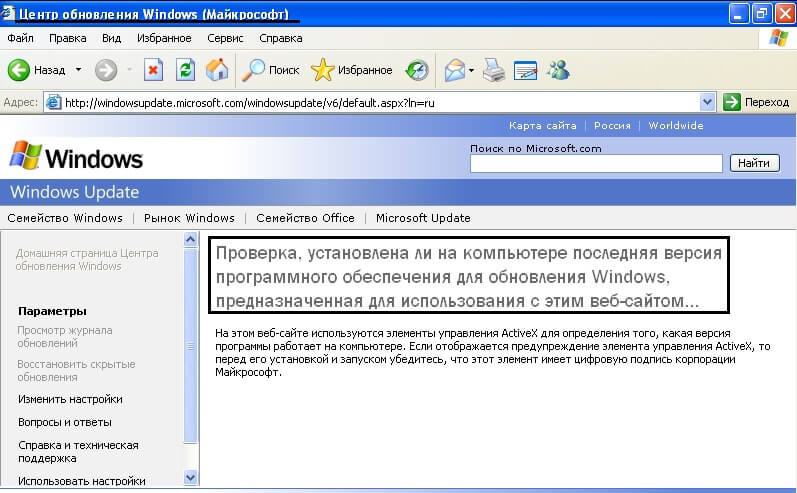
As soon as you do this, the system will start searching for updates, after which it will offer you to update everything at once or select only the ones you need. If you do not understand what update, what changes, then it is better to let the system update completely.
After downloading all updates, the operating system will require you to restart your computer to apply the new settings. Click "OK" and wait patiently. That's all, now you can connect the USB flash drive and use it.
If you decide to choose which updates should be installed, rather than downloading them all to automatic mode, then here's a guideline to help improve the system's perception of USB drives.
Driver conflicts in Windows XP
There is also a problem of driver conflict. The fact is that some already outdated drivers can cause errors at the system level; moreover, they can interfere with the normal operation of new drivers. A striking example of such a problem is a situation when a user inserts a USB flash drive into a computer, tries to access data on it, and the system immediately knocks out an error message asking to insert a disc. Or, the system simply freezes, and even assigning an already existing letter to a flash drive partition is real.
The reason for these errors is as follows. Let's say you have two flash drives, you connected one of them to the system. In automatic mode, all the necessary drivers for this device are immediately installed. You did the necessary manipulations to write or read files and pulled out the drive. After that, you insert a second USB flash drive, which is completely functional, and one of the above errors pops up. This means that the system is trying to use the already installed driver from the first flash drive to run the second, but they are not compatible.
Reinstalling Windows XP USB Drivers
This problem can be easily fixed in several ways. Reinstalling drivers in automatic mode or manual. Let's analyze a little theory, a driver from one USB device can be mistakenly used by the system to start another USB device. To eliminate these problems, we need to first remove all existing drivers for USB drives, and then reinstall them.
Such a problem may display the message "USB device not recognized", or unexplained processes occur at the system level that block access to data or cause the system to freeze.
Delete via DriveCleanup
You can effectively remove all existing USB device drivers using the DriveCleanup utility. Its advantage is that it searches the entire system for the presence of installed drivers and only then deletes them.
First of all, turn off the computer, disconnect all USB devices from it in order to avoid conflict situations while the program is running. We turn on the PC, go to the official website of the program and download the executable file. The utility is compatible with any version of Windows, including different bitness. When downloading, pay attention to the version of the file.
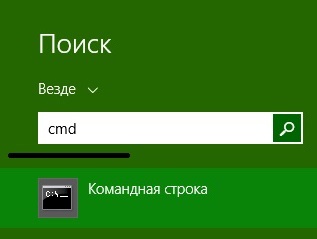
Automatic installation
You have removed all drivers from your computer. For the device to function normally, the operating system must have drivers for it. Process automatic installation The driver is incredibly simple, you just need to plug the USB flash drive into the USB port, and then the installation will start immediately. A window will pop up that will display the progress of the installation, on some systems this may occur in a mode invisible to the user. Installation is complete within one to two minutes and you can use your device.
Manual installation
Under manual installation installation of drivers is implied not directly from the storage medium itself. We can also install drivers for a flash drive from third-party Internet resources, but in order to avoid conflicts, we will install drivers for a flash drive using another computer.
So, we take our problematic flash drive, insert it into another computer, where it is recognized. A prerequisite for this process is the coincidence of Windows versions on both computers. We use the system search and find two files.
By any means we transfer them to the problem computer, be it sending by mail or using other removable media. You need to place these files in a folder with the same path that was on the first computer and confirm the replacement when the corresponding window pops up. We reboot the computer and enjoy its performance with FLASH disks.
We have considered only the most common reasons why the USB flash drive is not displayed on the computer. In fact, there are many more of them. Moreover, there are problems that are expressed by other system messages, and their solution is already described in the paragraphs of the article.
The message "Insert disc" appears, even if the flash drive is already connected to the USB port
This system error occurs if the drivers overlap and interfere with the normal functioning of USB devices. In order to fix this error, you need to remove all drivers for USB devices and reinstall them. This process is described step by step in this article.
Disk formatting message
This message appears if you are using a USB flash drive for the first time or a system failure has occurred in it. In addition to the message, you can make sure that it is not suitable for use, because it does not display any free space nor busy. The solution to this issue is described in detail in paragraphs 8 and 9.
Data error message
This problem pops up in 3 cases. This is a driver conflict, a file system conflict and a failure of the flash drive itself. It is solved by reinstalling the drivers, if it did not help, then quick formatting in order to preserve the ability to recover data on a USB flash drive. See above for step-by-step instructions.
Complete system freeze immediately after connecting the flash drive to the computer
This issue has already been discussed in the article, but I would like to draw your attention to the fact that this error can occur for two reasons:
- Driver conflict.
- Bad port.
It is easy to check what problem you have, insert the USB flash drive into another port, if the hang continues, then there is a problem with the drivers. Instructions and tips for reinstalling them were given within the framework of this article.
Why the computer does not see the USB flash drive when the indicator on it is on
The contact on the flash drive, which is responsible for the transfer of information, may be damaged. It is possible that there is a conflict of drivers and the assignment of a busy letter for a partition. If the problem persists, after connecting the flash drive to another computer, try to check the availability of the partition. If everything is in order here, then reinstall the drivers and the flash drive will work.
Error 43 / Error 43
This error immediately stops reading information from a removable device, which means that we will not be able to access the data immediately. There are several problems that Error 43 can cause.
- The failure of the device itself is the first of them. Check on another computer if this situation occurs again.
- Driver Conflict - The solution is described above.
- Updating the hardware configuration - you just need to roll back the driver version in the Task Manager.
conclusions
We got acquainted in detail with the reasons that can interfere with the reading of the flash drive and the information on it by the computer. Described solutions with step by step instructions will definitely help you get rid of this problem. The unreadable flash drive can only be a verdict if the flash drive is faulty. In other situations, this is an easily reversible process. If you have any questions or you could not find a solution to your problem in the article - leave comments, we will try to clarify the situation together.
Of course, after detecting problems and malfunctions with a flash drive, each person asks the question of the true cause of this malfunction or breakdown. If the laptop does not see the usb media, then most likely this is a consequence of two possible faults in the electronics: either the usb port or the flash card itself.
A working flash drive that is connected to a properly working USB port of a computer or laptop must blink, since this light indicator is an indication of the operability of the removable media and the computer. Therefore, if a laptop, then such a light indicator will not be highlighted in the prescribed way. When the first signs appear that you need to try rearranging it to different ports. If it does not work in any of the usb ports, then we can safely talk about possible problems.
The main reasons that the laptop does not see the USB flash drive
1. The most common cause of problems with a flash card is improper use of removable media. Very often users of computers or laptops connect it to the front panel system unit, as a result of which the computer does not perceive the usb media. The problem of the lack of contacts on the front panel with a plug-in flash card is not a malfunction of the system unit, but the lack of connection to the power supply at this port. 
2. Why does the laptop not see the USB flash drive? The answer to this question is of great interest to laptop and computer users who are faced with a malfunction of flash cards. One of the reasons for such problems may be a malfunction of the power supply of the system unit or too huge pressure current to the usb port. That is, in order to restore correct work flash cards and a computer, you just need to correctly distribute the load on your PC. Therefore, you should remember and do not forget that a new removable device can be connected only if many such media are not connected to the computer, otherwise you need to disconnect several of them.
The problem that worries many users of computers and laptops, that is, those cases in which the laptop does not see flash cards, can have a lot of reasons. For example, not only its ports, but also the flash drive itself may be to blame for this.
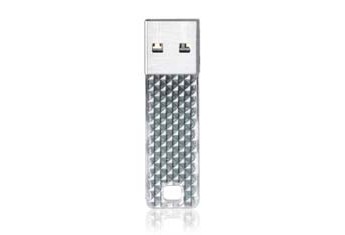 It often happens that the usb media is incorrectly removed from the computer after dropping all the files to or from the computer, that is, the owner of the flash drive simply pulls it out of the usb port. Such careless ejection shortens the life of the flash card significantly.
It often happens that the usb media is incorrectly removed from the computer after dropping all the files to or from the computer, that is, the owner of the flash drive simply pulls it out of the usb port. Such careless ejection shortens the life of the flash card significantly.
Also, the fact that the laptop does not see the USB flash drive may be to blame for the lack of software for this removable media in a personal computer. Usually, there is a set of program files on flash drives, thanks to which computers and laptops perceive the flash cards themselves as removable media, but due to improper use, these files may also be damaged.
What technology has reached! It's just something! If once, 10-15 years ago, we had to use heavy and large so-called hard drives, now a very small (with a finger) board fits more than a hundred gigabytes of clean memory. Memory cards (flash drives) are much more convenient, cheaper, and have the ability to almost never break. However, there are times when the flash card stops working when the laptop does not see the flash drive. Questions arise: why and what to do? Let's figure it out.
Reasons why a laptop may not see flash cards
In fact, the reasons can be very different, and very often there are such situations that the problem ends up not in the flash card, but in the computer, laptop or netbook. But it also happens that problems are really with the memory card itself. To find out if your flash card is working, you need to connect it to the USB port and carefully look at the device while connecting. If the special LED signal lights up, then everything is in order with your card. But then, when the light does not light up, we can assume that, most likely, your laptop does not see the USB flash drive.
Very often, because of a misunderstanding of what is happening with their flash drive or laptop, users begin to worry and do whatever comes to mind with it. They start shoving a small defenseless memory card into all available ports, if only it works. But to really think about why the laptop does not see the bootable USB flash drive, no one even tries. People hope that just about, right on the next plug-in into the laptop, the flash card will take and start working by itself, as if nothing had happened with it. But, in fact, this is impossible.
Laptop socket malfunction
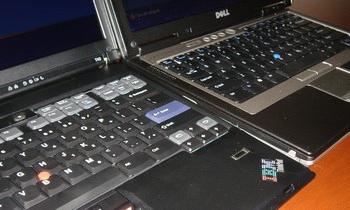
All your worries may turn out to be unfounded if it happens that the USB socket on the laptop simply does not work. Very often people throw away flash drives due to the fact that the laptop does not see them, without even trying to first insert the flash card into another computer or netbook. After all, why buy a new one (spend extra money), if the old one is still capable of working ?! This is especially true for photographers. After all, it is these people who have really important documents on their flash cards. When the laptop stops seeing it, they simply throw away the USB flash drive. But it was worth before this step just to try to find the answer to the question: "Why does the laptop not see the camera's flash drive?"
Inattentive user

Often there are situations when this or that laptop, take, for example, ASUS, does not detect a USB flash drive just because the system has disabled support for YUSB. This does not mean that you or someone else turned it off, this can happen even during an ordinary laptop power failure. In addition, in such a situation, the flash drive is often simply not recognized by the computer, and instead of the safe removal icon, a yellow triangle with a small exclamation mark appears in the lower right corner of the screen. But if ASUS laptop does not see the flash drive, you do not need to be upset, everything can be fixed!
Double-check: could the problem be with the laptop?
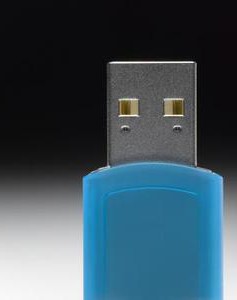
It's great if you have another laptop or netbook on hand, and a computer will work too! After all, only with the help of another computer can you be sure that the problem is real in the flash drive itself, or find out that the socket in your laptop is broken, and it urgently needs to be repaired. Insert the flash drive into another slot and, if nothing happens again, make sure that the problem is in the flash drive. In this case, it will be difficult to restore it on your own, because this already requires the help of specialists who know their business. In such a situation, it will be easiest to forget about the flash drive and buy a new one. But if this option does not suit you, quickly gather your thoughts and let's think, why the laptop does not see the USB flash drive?
The problem is in the drivers
If we talk about drivers, then this is also a very common situation. Problems with drivers are often found precisely on old laptop models, where they are simply outdated, which is why the laptop itself cannot detect the memory card. The most simple solution such a problem is an ordinary driver update. You can easily download them from the official website of your laptop manufacturer in a couple of minutes. But in no case download these or those drivers from outside Internet resources!

This can be dangerous for a laptop, because you can accidentally pick up the most common virus on the Internet, which will then have to be removed. But not all viruses can be removed, there are some that only true professionals can handle. If, after updating the drivers, the laptop does not see the USB flash drive, then we go to look for the real problem further!
System malfunction
It may be that your system simply, when connecting a flash card to a laptop, thinks that the flash drive is already open in the explorer. Well, to be more precise, the laptop assigns the USB flash drive the name of the disk that is already in the system of your device. But problems of this nature are resolved very quickly. To do this, you need to go to the laptop control panel, then select the item under the name "Administration" there, and then click on "Computer management". Next, a window of normal size opens, in which you need to click on "Storage Devices", and then select "Computer Disk Management". After completing these steps, you will see a list of all disks on your system, including the flash card itself. Find a CD-flash drive, press right button mouse, then click on "Change the letter of the CD-drive ..." and select the letter that has not yet been linked. If this was the only problem, then the laptop should see the USB flash drive.
The presence of "uninvited guests" (viruses) in the system

Often, the reason that a laptop does not see a USB flash drive is the presence of viruses, which will not be so easy to remove on your own. But you have to try! And what to do in such a difficult situation - you ask? And the answer is simple! You need to use a quality antivirus. But before that, it is imperative to update the entire system to the newest (latest) version, because if this is not done, the effect may not be the same as you expect. In the event that the acquisition official version Antivirus is impossible for some reason (for example, there is not enough money), then it is best to use special free utilities, such as, for example, Mc Afee Free. Under no circumstances download any dubious antivirus software from the Global Network. Firstly, you can infect your laptop even more, and secondly, make it so that no one can repair your device. Therefore, it is better not to risk it.
PC file systems conflict
Another common problem due to which the laptop does not see the SD-flash drive is the conflict situations of the file systems of your personal computer... This often happens when the file system of your flash drive is called FAT32, but your computer (laptop, netbook) is called NTFS. There is only one way out, there is simply no other. You will have to format the flash drive, otherwise you will have to throw it away, or give it to someone whose laptop can “feel” a flash card with just such a file system. It should be remembered that during the formatting of this or that flash drive, all data from it is deleted, and no specialist can restore them! Therefore, be careful!
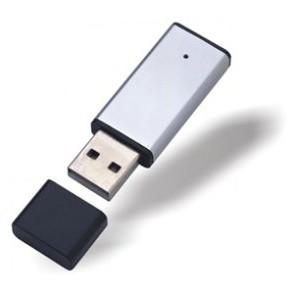
And what do we have? If the whole problem is hidden inside your PC, then you can easily solve it yourself, but if the situation is such that the problem is with the flash drive itself, then you will have to turn to real specialists, because it will be almost impossible to "reanimate" the memory card yourself.
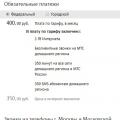 How to switch to “Smart mini” tariff from MTS for free - how to connect or disconnect TP?
How to switch to “Smart mini” tariff from MTS for free - how to connect or disconnect TP? Beeline bonuses: accrual, accumulation, use
Beeline bonuses: accrual, accumulation, use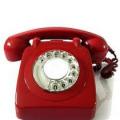 How to call America is not difficult
How to call America is not difficult